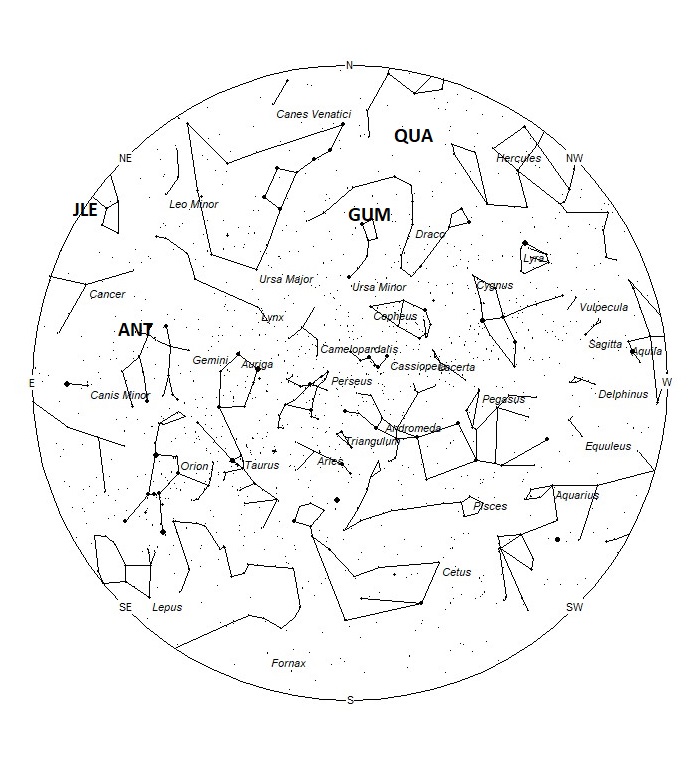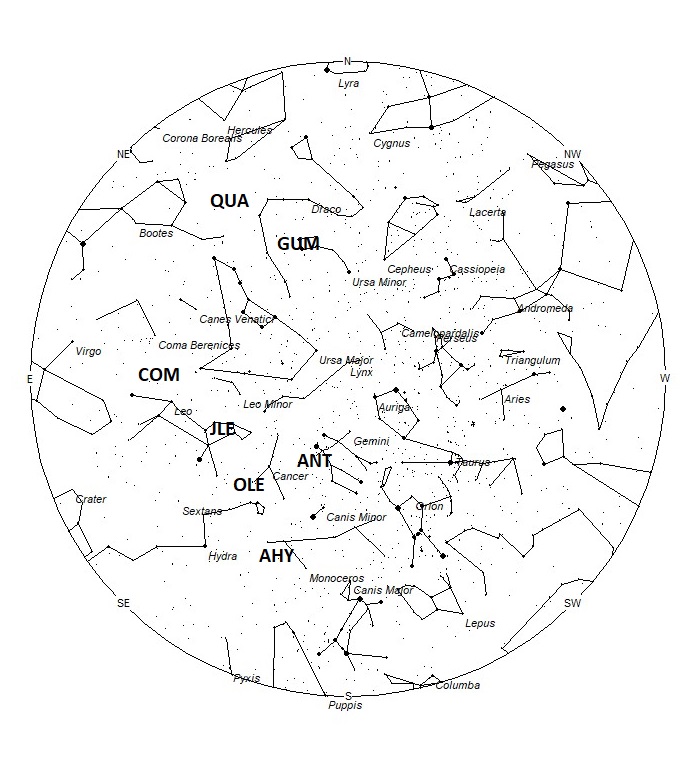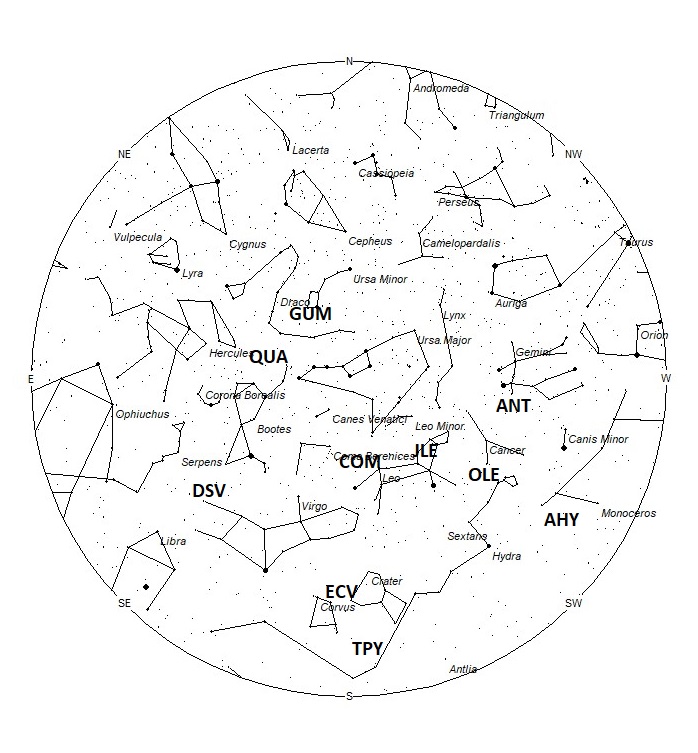During this period, the moon reaches its new phase on Thursday January 11th. At that time the moon will lie near the sun and will be invisible at night. This weekend the waning crescent moon will rise during the early morning hours and will not be a nuisance as long as you keep it out of your field of view. The estimated total hourly rates for evening observers this weekend should be near 4 as seen from mid-northern latitudes (45N) and 3 as seen from tropical southern locations (25S) For morning observers, the estimated total hourly rates should be near 15 as seen from mid-northern latitudes (45N) and 11 as seen from tropical southern locations (25S). The actual rates seen will also depend on factors such as personal light and motion perception, local weather conditions, alertness, and experience in watching meteor activity. Morning rates are slightly reduced due to moonlight. Note that the hourly rates listed below are estimates as viewed from dark sky sites away from urban light sources. Observers viewing from urban areas will see less activity as only the brighter meteors will be visible from such locations.
The radiant (the area of the sky where meteors appear to shoot from) positions and rates listed below are exact for Saturday night/Sunday morning January 6/7. These positions do not change greatly day to day so the listed coordinates may be used during this entire period. Most star atlases (available at science stores and planetariums) will provide maps with grid lines of the celestial coordinates so that you may find out exactly where these positions are located in the sky. I have also included charts of the sky that display the radiant positions for evening, midnight, and morning. The center of each chart is the sky directly overhead at the appropriate hour. These charts are oriented for facing south but can be used for any direction by rotating the charts to the desired direction. A planisphere or computer planetarium program is also useful in showing the sky at any time of night on any date of the year. Activity from each radiant is best seen when it is positioned highest in the sky, either due north or south along the meridian, depending on your latitude. Radiants that rise after midnight will not reach their highest point in the sky until daylight. For these radiants, it is best to view them during the last few hours before dawn. It must be remembered that meteor activity is rarely seen at its radiant position. Rather they shoot outwards from the radiant, so it is best to center your field of view so that the radiant lies toward the edge and not the center. Viewing there will allow you to easily trace the path of each meteor back to the radiant (if it is a shower member) or in another direction if it is sporadic. Meteor activity is not seen from radiants that are located far below the horizon. The positions below are listed in a west to east manner in order of right ascension (celestial longitude). The positions listed first are located further west therefore are accessible earlier in the night while those listed further down the list rise later in the night.
These sources of meteoric activity are expected to be active this week
.
The large Anthelion (ANT) is currently centered at 07:56 (119) +21. This position lies in southeastern Gemini, 7 degrees southeast of the 1st magnitude star known as Pollux (beta Geminorum). Due to the large size of this radiant, these meteors may also be seen from western Cancer as well as Gemini. This radiant is best placed near 01:00 local standard time (LST) when it lies on the meridian and is highest in the sky. Rates at this time should be near 2 per hour as seen from the northern hemisphere and 1 per hour as seen from south of the equator. With an entry velocity of 30 km/sec., the average Anthelion meteor would be of slow velocity.
The alpha Hydrids (AHY) were discovered by Dr. Peter Brown and are mentioned in his article “A meteoroid stream survey using the Canadian Meteor Orbit Radar”. This shower is active from December 15 through January 22 with maximum activity occurring on January 6th. The radiant is currently located at 08:34 (129) -09. This position lies in western Hydra, 13 degrees west of the 2nd magnitude star known as Alphard (alpha Hydrae). These meteors are best seen near 0200 LST when the radiant lies highest above the horizon. At 43 km/sec. the alpha Hydrids produce meteors of medium velocity. Expected rates this week are near 1 per hour no matter your location.
The Omicron Leonids (OLE) were also discovered by Damir Šegon and the Croatian Meteor Network team based on studying SonotaCo and CMN observations (SonotaCo 2007-2011, CMN 2007-2010). These meteors are active from December 20 through January 22. Maximum activity occurs on January 9th. The radiant is currently located at 09:04 (135) +10. This position lies in southeastern Cancer, 2 degrees southeast of the 4th magnitude star known as Acubens (alpha Cancri). These meteors are best seen near 0200 LST when the radiant lies highest above the horizon. At 41 km/sec. the omicron Leonids produce meteors of medium velocity. Expected rates this week are less than 1 per hour no matter your location.
The last of the January Leonids (JLE) are expected this week from a radiant located at 10:01 (150) +23. This area of the sky is located in western Leo, 3 degrees west of the 3rd magnitude star known as Adhafera (zeta Leonis). Rates at this time are expected to be less than 1 per hour no matter your location. At 52 km/sec. these meteors are of a medium-fast velocity.
The last of the theta Pyxidids (TPY) are expected this week from a radiant located at 11:36 (174) -29. This area of the sky is located in central Hydra, 3 degrees north of the 4th magnitude star known as xi Hydrae. Rates at this time are expected to be less than 1 per hour no matter your location. At 65 km/sec. these meteors are of a medium-fast velocity.
The Comae Berenicids (COM) is a shower of long duration active from December 5th all the way through February 4th. Maximum occurred near December 15th when rates may have reached 3 an hour. During this period, I would expect hourly rates of 2 from a radiant located at 11:48 (177) +23. This position lies in northeastern Leo, 8 degrees north of the 2nd magnitude star known as Denebola (beta Leonis). These meteors are best seen near 0500 LST when the radiant lies highest above the horizon. At 63 km/sec. the Comae Berenicids produce mostly swift meteors.
The eta Corvids (ECV) were recently discovered by Sirko Molau and the IMO Video Meteor Network Team. This stream is active from January 7-February 5, with maximum activity occurring on January 21st. The current position of the radiant is 11:54 (178) -16, which places the radiant in eastern Crater, 5 degrees northwest of the 3rd magnitude star known as Gienah (gamma Corvi A). These meteors are best seen near 0500 LST when the radiant lies highest above the horizon. Current hourly rates would be less than 1 per hour no matter your location. At 67 km/sec. these meteors would be fast.
The December sigma Virginids (DSV) was discovered by John Greaves using the data of SonotaCo. This source is active from November 28 through January 24 with peak rates occurring near December 21st. The current radiant location is at 14:41 (220) +04 which places it in extreme northeastern Virgo, 2 degrees north of the faint star known as 109 Virginis. Current hourly rates would be less than 1 no matter your location. These meteors are best seen during the last dark hour before dawn, when the radiant lies highest above the horizon in a dark sky. At 66 km/sec. the December Sigma Virginids would produce mostly swift meteors.
The gamma Ursae Minorids (GUM) are another source discovered by Dr. Peter Brown and associates. These meteors are active from January 9-20, with maximum activity occurring near January 18. The radiant is currently located at 15:08 (227) +72, which places it southern Ursa Minor only 1 degree southwest of the 3rd magnitude star known as Pherkad (gamma Ursae Minoris). These meteors are best seen during the last few hours before dawn, when the radiant lies highest in a dark sky. Current rates are less than 1 per hour no matter your location. These meteors encounter the atmosphere at 30 km/sec., which would produce meteors of medium-slow velocity.
The Quadrantids (QUA) are active from December 26th through January 16th. Maximum occurred on January 3rd. The radiant is currently located at 15:36 (234) +50. This position lies in northern Bootes. The nearest star of note is 3rd magnitude Edasich (iota Draconis), which lies 9 degrees to the north. These meteors are best seen during the last hour before dawn when the radiant lies highest above the horizon in a dark sky. Current rates are expected to be near 1 per as seen from the northern hemisphere and less than 1 as seen from south of the equator. At 40 km/sec. the Quadrantids produce meteors of moderate velocity. These meteors are visible from the southern tropics but not seen from the deep southern hemisphere.
Sporadic meteors are those meteors that cannot be associated with any known meteor shower. All meteor showers are evolving and disperse over time to the point where they are no longer recognizable. Away from the peaks of the major annual showers, these sporadic meteors make up the bulk of the activity seen each night. As seen from the mid-Northern Hemisphere (45N) one would expect to see during this period approximately 9 sporadic meteors per hour during the last hour before dawn as seen from rural observing sites. Evening rates would be near 3 per hour. As seen from the tropical Southern latitudes (25S), morning rates would be near 8 per hour as seen from rural observing sites and 2 per hour during the evening hours. Locations between these two extremes would see activity between these listed figures. Morning rates are slightly reduced due to moonlight.
You can keep track of the activity of these meteor showers as well as those beyond the limits of visual observing by visiting the NASA Meteor Shower Portal. You can move the sky globe to see different areas of the sky. Colored dots indicate shower meteors while white dots indicate sporadic (random) activity. The large orange disk indicates the position of the sun so little activity will be seen in that area of the sky.
The list below offers the information in tabular form of the showers that I feel are within reach of the visual observer to discern. Hourly rates are often less than 1 but noting parameters such as the duration, radiant distance and the elevation of each meteor, one can compute the probability of shower association. Most showers discovered by video means have rates less than 1 meteor per night away from maximum, so the showers listed in these articles are not as weak as they seem. Rates and positions are exact for Saturday night/Sunday morning.
| SHOWER | DATE OF MAXIMUM ACTIVITY | CELESTIAL POSITION | ENTRY VELOCITY | CULMINATION | HOURLY RATE | CLASS |
| RA (RA in Deg.) DEC | Km/Sec | Local Standard Time | North-South | |||
| Anthelions (ANT) | – | 07:56 (119) +21 | 30 | 01:00 | 2 -1 | II |
| alpha Hydrids (AHY) | Jan 06 | 08:34 (129) -09 | 43 | 02:00 | 1 – 1 | IV |
| omicron Leonids (OLE) | Jan 10 | 09:04 (135) +10 | 41 | 02:00 | <1 – <1 | IV |
| January Leonids (JLE) | Jan 03 | 09:42 (146) +25 | 52 | 03:00 | <1 – <1 | IV |
| theta Pyxidids (TPY) | Dec 18 | 11:36 (174) -29 | 65 | 05:00 | <1 – <1 | IV |
| Comae Berenicids (COM) | Dec 16 | 11:48 (177) +23 | 63 | 05:00 | 1- <1 | II |
| eta Corvids (ECV) | Jan 21 | 11:54 (178) -16 | 67 | 05:00 | <1- <1 | IV |
| December sigma Virginids (DSV) | Dec 21 | 14:41 (220) +04 | 66 | 08:00 | <1 – <1 | IV |
| gamma Ursae Minorids (GUM) | Jan 18 | 15:08 (227) +72 | 30 | 09:00 | <1 – <1 | IV |
| Quadrantids (QUA) | Jan 04 | 15:28 (232) +50 | 40 | 09:00 | 1 – <1 | I |
Class Explanation: A scale to group meteor showers by their intensity:
- Class I: the strongest annual showers with Zenith Hourly Rates normally ten or better.
- Class II: reliable minor showers with ZHR’s normally two to ten.
- Class III: showers that do not provide annual activity. These showers are rarely active yet have the potential to produce a major display on occasion.
- Class IV: weak minor showers with ZHR’s rarely exceeding two. The study of these showers is best left to experienced observers who use plotting and angular velocity estimates to determine shower association. These weak showers are also good targets for video and photographic work. Observers with less experience are urged to limit their shower associations to showers with a rating of I to III.




